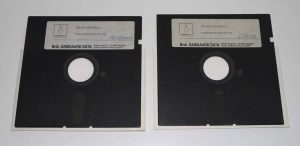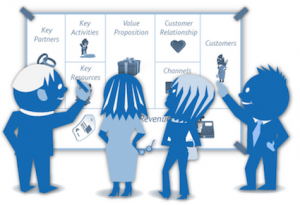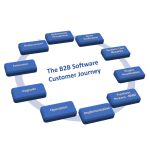How Can You Recognize a Great Business Idea?
 The short answer is that you can not. Nobody in this world has managed to find a bulletproof method to determine if a business idea is good or bad.
The short answer is that you can not. Nobody in this world has managed to find a bulletproof method to determine if a business idea is good or bad.
In the bright light of hindsight, we are all prophets. But in the real world, there are so many variables that we cannot predict with any reasonable certainty whether an idea will turn out to be successful or not.
In my book, 5,460 Miles from Silicon Valley, I describe in detail how Erik Damgaard was inspired to develop a bookkeeping system for very small businesses. He saw another bookkeeping system and believed that he could do better. And so he did.
Was it a good idea?
If you had asked others at that time, most would probably have said that “it exists already.” Some would have claimed that if you wanted to get into that market, you should bring truckloads of money to the party. There were so many competitors already.
Erik and his brother Preben borrowed $ 12,000 from their parents to import six CP/M computers from Taiwan. They sold four of them for a total of $ 12,000. The parents got their money back, and the brothers now had the two computers they needed to develop their first software product.
Team and execution
 The idea of developing a bookkeeping program was neither brilliant nor good, but it was executed in a short time, with minimal resources and with a few but crucial Unique Selling Points (USPs).
The idea of developing a bookkeeping program was neither brilliant nor good, but it was executed in a short time, with minimal resources and with a few but crucial Unique Selling Points (USPs).
Erik proved to be a gifted software developer. He managed to get the entire software squeezed onto a single floppy disk. This meant that the bookkeeper did not have to play disc jockey while working. With his mother’s help (she was a bookkeeper), Erik had developed the program so that it followed the logic of the paper-based world, from where most new users came. The product was easy to demonstrate and seemed user-friendly.
When they exhibited at Office & Data expo in autumn 1984, they had already signed up the first reseller via an acquaintance, and immediately after Finn Kusk called and asked for an OEM agreement, which became a great success.
Where is Preben?
He is Erik’s sparring partner and takes care of everything else other than the product development. As time passes, “everything else” fills out more and more. Damgaard Data could well have been started without Preben, but it could not have grown so big without him. Erik and Preben proved to be the perfect entrepreneurial team. You will have to read the book to get the finer details:-)
Market, timing, and pure luck
Erik and Preben entered an already crowded market but hit it at absolutely the right time. Their first product Danmax was based on CP/M microcomputers, which in 1984 cost around $ 10,000 with software and a printer. It was an acceptable price for small businesses. If they had chosen to bet on IBM’s DOS-based PC, the entry price would have been over $ 20,000. It would have been way too high.
 The situation changed over the next two years, and in the autumn of 1986, Erik Damgaard was ready with Concorde, which was not only a PC/DOS-based product but could also be used in networks, thus serving concurrent users (bigger companies).
The situation changed over the next two years, and in the autumn of 1986, Erik Damgaard was ready with Concorde, which was not only a PC/DOS-based product but could also be used in networks, thus serving concurrent users (bigger companies).
Had Erik and Preben rested on the laurels and used the profits from Danmax to buy big cars and join the jet set, they would have quickly lost out. They did not. They invested their profits in a new product, recruiting new employees and in a very ambitious marketing campaign for Concorde. With Danmax and Concorde, Damgaard Data achieved a turnover of over $ 20 million (1991/92). They used resellers who, on average, got a 40% discount and took care of customer support. Thus the market turnover was almost $ 40 million at this time.
Were Erik and Preben lucky?
Yes, they were, but it was not random lotto luck.
 Erik spent a semester at the University of South Carolina studying computer science – an initiative that only very few Danish students took at that time. During the stay, he discovered his interest and flair for software development. After returning home, he was presented with a bookkeeping system and looked at it very carefully. He developed a new bookkeeping system. Erik and Preben took out their savings so they could exhibit at the Office & Data Expo. They did not just rely on their reseller representing their interests.
Erik spent a semester at the University of South Carolina studying computer science – an initiative that only very few Danish students took at that time. During the stay, he discovered his interest and flair for software development. After returning home, he was presented with a bookkeeping system and looked at it very carefully. He developed a new bookkeeping system. Erik and Preben took out their savings so they could exhibit at the Office & Data Expo. They did not just rely on their reseller representing their interests.
The two brothers took a lot of initiatives which led them to the fortune. The CP/M choice turned out to be smart, but very short-lived. Then they quickly converted to MS-DOS.
Business luck seems so obvious on the surface, but if you dig a little deeper, you find that there are often a lot of initiatives and mistakes behind the good fortune. The Damgaard brothers did not make many mistakes at the start. Those came later.
The conclusion
 I am occasionally contacted by people who want me to evaluate their business idea. I decline categorically. I refer them to the professional investors who do this day in and day out. But I warn them that investors will put a lot of emphasis on how the idea is presented and whether they believe in the team behind the idea.
I am occasionally contacted by people who want me to evaluate their business idea. I decline categorically. I refer them to the professional investors who do this day in and day out. But I warn them that investors will put a lot of emphasis on how the idea is presented and whether they believe in the team behind the idea.
Successful businesses often end up miles from where they started. They do so because the great idea turned out to be bad, but the team invested hours, money and sweat and found another way to success.
If the conclusion is to be taken a step further, I would claim that you (you = all those who do not even plan to start a business) should refrain from guessing which types of businesses will be successful in the future.
There is hardly any doubt that they all will contain a great deal of technology and that software will be a supporting element. Whether it will be a new chain of hairdressers, a wine rating app, a new bookkeeping system, specialized drones, a new platform for delivering consultancy, toys, room temperature regulation or something else, we’ll have to leave it to the entrepreneurs to find out what is going to be successful.









